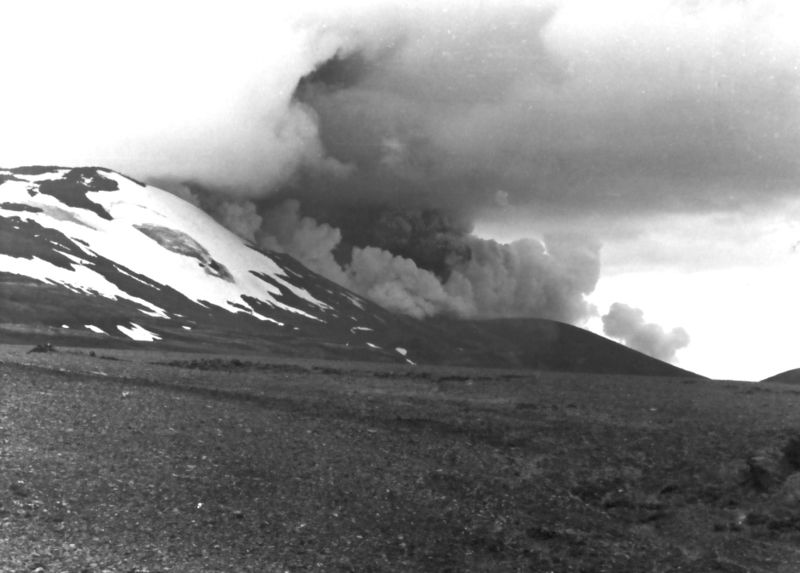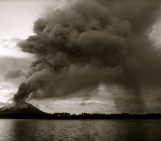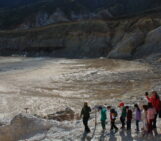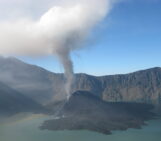Iceland is well known for its extensive volcanism. Situated amid the northernmost part of the Mid-Atlantic Ridge, the spreading centre is a hub of volcanic activity, from Krafla in the north to the young volcanic island of Surtsey in the south.

Simplified geological map of Iceland, showing the country’s larger volcanoes (click for larger). (Credit: Wikimedia Commons user Pinpin)
Hekla is one of the country’s most active volcanoes – both in terms of erupted material and eruption frequency, and lies at the heart of a 40 kilometre long, 7 kilometre wide volcanic system. This week’s Imaggeo on Mondays features a lava flow in Landmannalaugar, not far from the volcano:
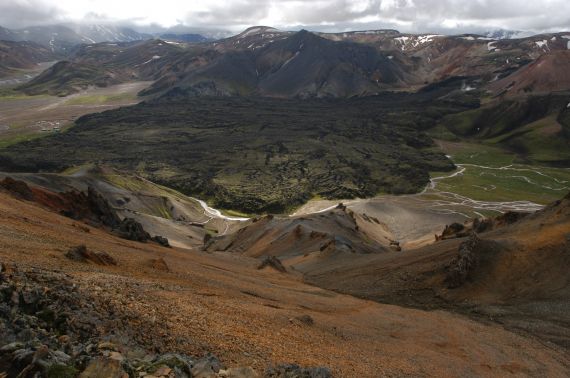
“Lava outflow in Iceland” by Wolfgang Schwanghart, who took this photo at Landmannalaugar in the Icelandic highlands. This image is distributed by the EGU under a Creative Commons licence.
The frequency of Hekla’s eruptions is reflected in its chemistry: long periods between eruptions correspond to the eruption of viscous, silica-rich magma known as rhyodacite, and shorter ones (30 years or fewer) result in the eruption of low-silica magmas, from andesite to basaltic andesite. Hekla’s historic eruptions have always begun explosively, but the magnitude and duration of this explosive period is dependent on the length of time between eruptions – the longer the gap, the more explosive the eruption.
Once the initial explosive phase is over, and the eruption becomes effusive Hekla releases large volumes of lava like the one above. Records show this is the case for all of the eruptions that have occurred during recorded history – the exception being the 1104 eruption, where it is not certain Hekla had an effusive phase.
The volcano has erupted in this pattern at intervals of about 55 years since the 1100’s. That is, until fairly recently. The last four eruptions occurred in 1970, 1980, 1991 and 2000, and may indicate that Hekla may be entering a new phase of activity – one characterised by relatively small, frequent eruptions.
References:
Gronvold, K., Larsen, G. , Einarsson, P. , Thorarinsson, S. and Saemundsson, K.: The Hekla eruption 1980–1981, Bulletin of Volcanology, 46, 349-363, 1983.
Gudmundsson, A., Oskarsson, N., Gronvold, K., Saemundsson, K., Sigurdsson, O., Stefansson, R., Gislason, S. R. et al.: The 1991 eruption of Hekla, Iceland. Bulletin of Volcanology, 54, 238-246, 1992.
Lacasse, C., Karlsdóttir, S., Larsen, G., Soosalu, H., Rose, W. I., and Ernst, G. G. J.: Weather radar observations of the Hekla 2000 eruption cloud, Iceland. Bulletin of Volcanology, 66, 457-473, 2004.
Thorarinsson, S. and Sigvaldason, G. E.: The Hekla eruption of 1970. Bulletin of Volcanology, 36, 269-2888, 1972.
Imaggeo is the EGU’s open access geosciences image repository. A new and improved Imaggeo site will be launching soon, so you will be able to peruse an even better database of visually stunning geoscience images. Photos uploaded to Imaggeo can be used by scientists, the press and the public provided the original author is credited. Photographers also retain full rights of use, as Imaggeo images are licensed and distributed by the EGU under a Creative Commons licence. You can submit your photos here.

